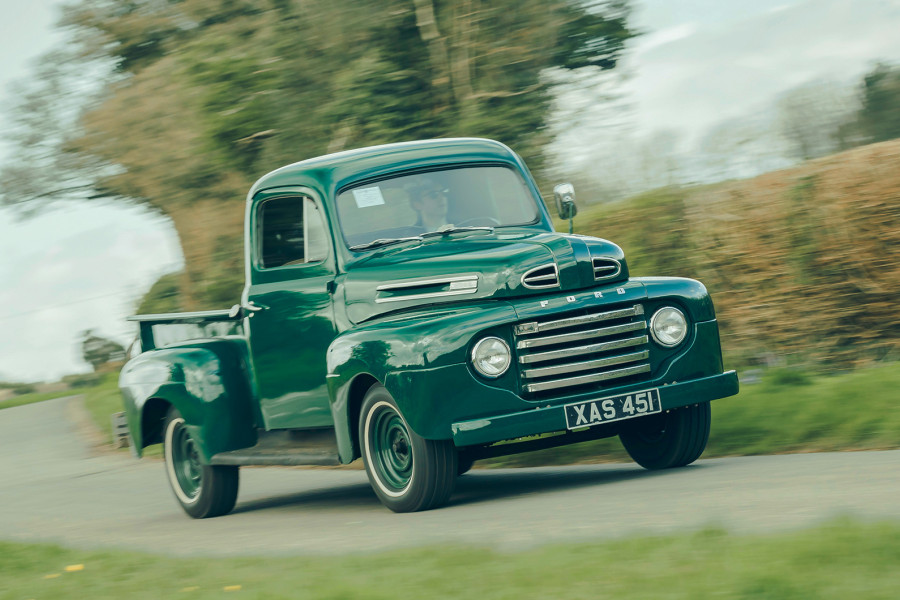Tony Waite’s splendid 1967 Meteor Blue Vauxhall left the Luton factory at a time when young blades in the sales team craved a Brabham Viva but the top floor demanded rather more in the way of creature comforts.
You can picture the Viscount chauffeuring various businessmen to a four-hour luncheon at the Post Office Tower and, when the PC line-up ended in ’72, no other Griffin-badged car would have the same blend of agreeable ostentation and considerable charm.
Vauxhall planned to replace the PC in late 1969, but financial problems meant that the PD was canned.
Viscount sales were limited by the early ’70s and its spiritual successor, the 1978 Royale, would be a quite different form of luxobarge.
Clockwise from top: the Austin wears plain hucaps; regal motif on the Viscount’s wheels; US-style hubcaps for the Ford
Indeed, each car marked the end of an era for their respective marques.
The Austin suffered in-house competition from the cheaper Wolseley 18/85, but the Rover V8-powered version might have achieved success.
As it was, this idea sadly never reached fruition – although the 1972 Wolseley Six demonstrated the potential of a six-cylinder Landcrab.
The Mk4 range bowed out a year before Ford of Europe was created and it was to be the last of Dagenham’s US-inspired large cars.
Not even a two-tone Mk2 Granada Ghia Sapphire had quite the same blend of flamboyance and forcefulness as the Executive.
Our author has made his choice – what’s yours, Ford, Austin or Vauxhall?
Each of these impressive machines reflects a very different aspect of 1960s British life.
The Executive feels as if it was made for ‘the man on the move’, to use a popular phrase of the time, poised to dash to the next planners’ meeting for a shopping precinct near Crawley.
The Austin is low-key, supremely comfortable and altogether perfect for the chap who once bemoaned Sgt Pepper’s Lonely Hearts Club Band and the demise of the BBC Home Service.
That leaves the Viscount, a fairly bulky saloon of unabashed social pretension and a definite modicum of style. In other words, it is my ideal car.
Images: Tony Baker
Thanks to Austin 3 Litre OC; Mk4 Zephyr Zodiac OC; Vauxhall Cresta Club; Kempton Steam Museum
This was originally published in our November 2017 magazine
Factfiles
Austin 3 Litre
- Sold/number built 1967-’71/9992
- Construction steel monocoque
- Engine all-iron, ohv 2912cc straight-six, twin SU HS6 carburettors
- Max power 124bhp @ 4500rpm
- Max torque 161lb ft @ 3000rpm
- Transmission four-speed manual, with optional o/d, or three-speed BW auto, RWD
- Suspension independent, at front by double wishbones rear semi-trailing arms; Hydrolastic units f/r, interconnected, self-levelling at rear
- Steering power-assisted rack and pinion
- Brakes discs front, drums rear, with servo
- Length 15ft 5¾in (4718mm)
- Width 5ft 6¾in (1695mm)
- Height 4ft 8in (1422mm)
- Wheelbase 9ft 7½ in (2932mm)
- Weight 3377lb (1529kg)
- Mpg 18-22
- 0-60mph 16 secs
- Top speed 98mph
- Price new £1696 5s
Ford Executive
- Sold/number built 1966-’71/46,846 (inc Mk4 Zodiacs)
- Construction steel monocoque
- Engine all-iron, ohv 2994cc V6, twin-choke Weber 40DFA carburettor
- Max power 136bhp @ 4750rpm
- Max torque 181lb ft @ 3000rpm
- Transmission three-speed auto or four-speed man with o/d, RWD
- Suspension independent, at front by MacPherson struts, anti-roll bar rear semi-trailing arms, coils; telescopics f/r
- Steering power-assisted recirculating ball
- Brakes discs all round, with servo
- Length 15ft 5½in (4712mm)
- Width 5ft 11½in (1816mm)
- Height 4ft 10in (1473mm)
- Wheelbase 9ft 7in (2921mm)
- Weight 3069lb (1392kg)
- Mpg 18-20
- 0-60mph 11 secs
- Top speed 103mph
- Price new £1846 1s 2d
Vauxhall Viscount
- Sold/number built 1966-’72/7025
- Construction steel monocoque
- Engine all-iron, ohv 3294cc straight-six, Zenith 42W carburettor
- Max power 120bhp @ 4700rpm
- Max torque 176lb ft @ 2400rpm
- Transmission two-speed automatic, RWD
- Suspension: front independent, by double wishbones, coil springs, a-r bar rear live axle, leaf springs, inclined tie-rod; telescopics f/r
- Steering power-assisted recirculating ball
- Brakes discs front, drums rear, with servo
- Length 15ft 7in (4750mm)
- Width 5ft 10in (1778mm)
- Height 4ft 9in (1448mm)
- Wheelbase 8ft 11½in (2731mm)
- Weight 3080lb (1397kg)
- Mpg 16-22
- 0-60mph 15.5 secs
- Top speed 98mph
- Price new £1482 17s 4d
READ MORE
Guilty pleasures: Vauxhall Viscount
Vauxhall Royale: Luton’s classiest coupé?
Buyer’s guide: Ford Consul, Zephyr and Zodiac
Andrew Roberts
Andrew is a long-time contributor to Classic & Sports Car
























